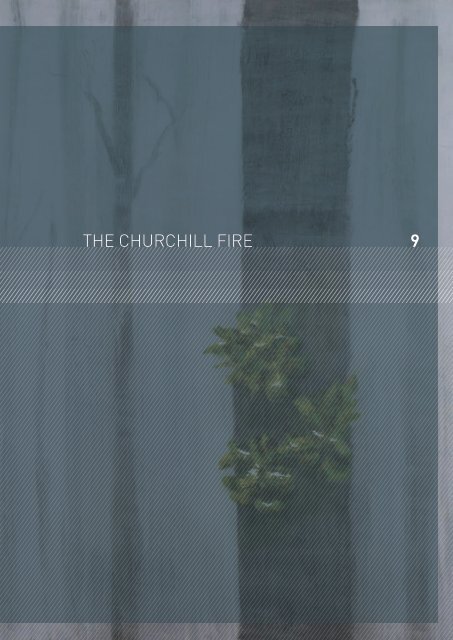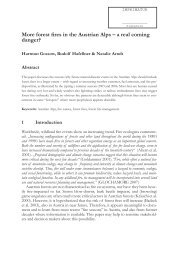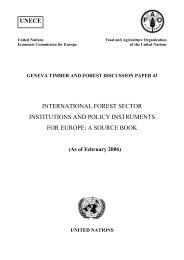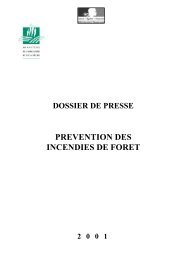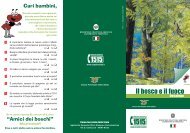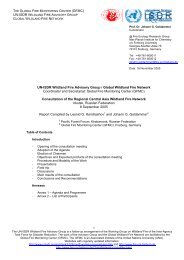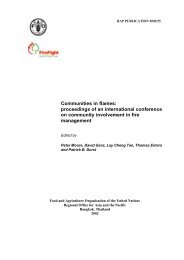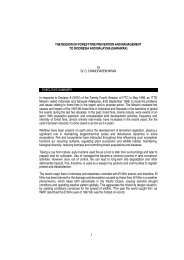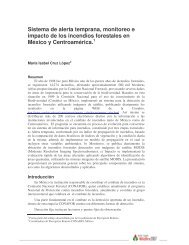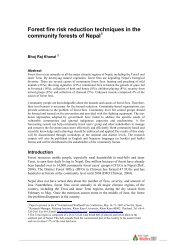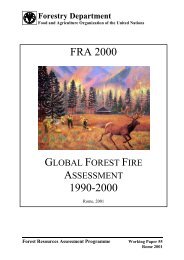the Churchill fires - 2009 Victorian Bushfires Royal Commission
the Churchill fires - 2009 Victorian Bushfires Royal Commission
the Churchill fires - 2009 Victorian Bushfires Royal Commission
You also want an ePaper? Increase the reach of your titles
YUMPU automatically turns print PDFs into web optimized ePapers that Google loves.
THE CHURCHILL FIRE<br />
9
128<br />
Volume I: The Fires and <strong>the</strong> Fire-Related Deaths<br />
9 THe CHurCHill Fire<br />
<strong>Churchill</strong> is about 160 kilometres south-east of Melbourne, in Latrobe City and Wellington Shires, which are part of<br />
<strong>the</strong> Latrobe Valley.<br />
The <strong>Churchill</strong> fire started at about 13:32 on 7 February <strong>2009</strong>, 3 kilometres south-east of <strong>the</strong> <strong>Churchill</strong> fire station.<br />
During <strong>the</strong> afternoon and early evening <strong>the</strong> fire travelled rapidly, affecting Jeeralang North, Balook, Le Roy, Koornalla,<br />
Callignee, Callignee North, Callignee South, Hazelwood South, Hazelwood North, Traralgon South, Devon, Yarram<br />
and Carrajung South. The Loy Yang power station, part of Victoria’s critical infrastructure, is about 25 kilometres<br />
from <strong>Churchill</strong> and came under threat.<br />
Although <strong>the</strong> fire was at its most destructive on 7 February, it was not reported as controlled until 19 February.<br />
Eleven people died as a result of <strong>the</strong> fire, 145 houses were destroyed, and more than 25,861 hectares were burnt.<br />
Figure 9.1 shows <strong>the</strong> extent of <strong>the</strong> fire.<br />
Overview<br />
Maximum temperature The maximum temperature recorded was 46.1°C at Latrobe Valley automatic<br />
wea<strong>the</strong>r station at 16:02. 1<br />
Minimum relative humidity The minimum relative humidity recorded on 7 February was 8 per cent at<br />
Latrobe Valley AWS at 15:43. 2<br />
Wind The maximum winds recorded before <strong>the</strong> wind change were north-north-westerly<br />
at 44 kilometres an hour at Latrobe Valley AWS at 15:43. 3<br />
The south-westerly wind change was recorded by <strong>the</strong> Latrobe Valley AWS at 18:18. 4<br />
The maximum winds recorded after <strong>the</strong> wind change were 46 kilometres an hour at<br />
Latrobe Valley AWS at 18:20. 5<br />
Fire danger index The maximum Forest Fire Danger Index was 103 at Latrobe Valley AWS at 16:00. 6<br />
Cause Suspicious. 7<br />
Fatalities Eleven fatalities. 8<br />
Casualties Thirty-five casualties. 9<br />
Houses destroyed One hundred and forty-five houses. 10<br />
Overall area burnt 25,861 hectares. 11<br />
Firefighting resources On 7 February 409 CFA and 167 NEO personnel attended <strong>the</strong> fire. They were<br />
supported by 76 CFA appliances, 29 NEO appliances and 4 aircraft. 33 HVP<br />
firefighters also provided support. 12
Figure 9.1 The <strong>Churchill</strong> fire<br />
Hazelwood<br />
Gormandale<br />
WHITELAWS TRACK<br />
CALLIGNEE SOUTH ROAD<br />
Lvw & sb<br />
Reservoir<br />
MERRIMANS CREEK ROAD<br />
SWITCHBACK ROAD<br />
Koornalla<br />
<strong>Churchill</strong><br />
Callignee North<br />
<strong>Churchill</strong><br />
13:32<br />
Approximate Fire Front<br />
16:50<br />
Source: Exhibit 994 – <strong>Churchill</strong> Fire – Fire Spread Map. 13<br />
Callignee<br />
Willung South<br />
TRARALGON CREEK ROAD<br />
BOOLARRA-CHURCHILL ROAD<br />
Jeeralang Junction<br />
20:30<br />
Jeeralang North<br />
Carrajung<br />
Callignee South<br />
Carrajung South<br />
TRARALGON-BALOOK ROAD<br />
Yinnar South<br />
19:39<br />
Carrajung Lower<br />
CARRAJUNG-WOODSIDE ROAD<br />
Le Roy<br />
JUMBUK ROAD<br />
Blackwarry<br />
Jeeralang<br />
HYLAND HIGHWAY<br />
CARRAJUNG LOWER ROAD<br />
THE GRAND RIDGE ROAD<br />
17:18<br />
15:00<br />
15:00<br />
Jumbuk<br />
Budgeree<br />
14:49<br />
Balook<br />
Budgeree East<br />
YARRAM-BLACKWARRY ROAD<br />
Valley View<br />
BUDGEREE ROAD<br />
Darriman<br />
BULGA PARK ROAD<br />
JEERALANG WEST ROAD<br />
20:36<br />
Macks Creek Won Wron<br />
TARRA VALLEY ROAD<br />
NAPIER ROAD<br />
BAXTERS<br />
ROAD<br />
Womerah<br />
Tarra Valley<br />
Calrossie<br />
Woodside North<br />
Napier<br />
WON WRON ROAD<br />
GRAND RIDGE ROAD<br />
Madalya<br />
Johnstones Hill<br />
Kallady Whitelaw<br />
18:05<br />
Glen Rose<br />
ALBERT RIVER ROAD<br />
Woodside<br />
Devon<br />
Hiawatha<br />
Christies<br />
Woodside<br />
East<br />
SOUTH GIPPSLAND HIGHWAY<br />
Greenmount<br />
15:02<br />
BALLOONG ROAD<br />
MCLOUGHLINS BEACH ROAD<br />
YARRAM-MORWELL ROAD<br />
Staceys Bridge<br />
Tooloonook<br />
18:04<br />
OLD SALE ROAD<br />
Yarram<br />
GELLIONDALE ROAD<br />
ALBERT RIVER-WELSHPOOL ROAD<br />
Wonyip<br />
WOORARRA ROAD<br />
Fire spread<br />
Fire-affected area–18:00<br />
N<br />
0 2 4 Kilometres<br />
The <strong>Churchill</strong> fire<br />
Fire origin<br />
Final fire perimeter<br />
Spot fire<br />
Roads<br />
Rivers/creeks<br />
129<br />
N<br />
N
130<br />
Volume I: The Fires and <strong>the</strong> Fire-Related Deaths<br />
<strong>Churchill</strong><br />
The following time line summarises events associated with <strong>the</strong> <strong>Churchill</strong> fire. For <strong>the</strong> most part, <strong>the</strong> times<br />
given are approximate. Fur<strong>the</strong>r details about <strong>the</strong> events are provided in <strong>the</strong> accompanying narrative.<br />
7 February<br />
CFA Incident<br />
Controller<br />
arrives at ICC<br />
7–19 February<br />
13:45<br />
First joint<br />
urgent threat<br />
message<br />
issued<br />
First 000 call<br />
received<br />
14:00<br />
Latrobe City<br />
MECC activated<br />
14:15<br />
Pre-formed DSE<br />
IMT integrated<br />
with existing<br />
CFA-led IMT<br />
Spot fire<br />
several<br />
kilometres<br />
west of<br />
Balook<br />
14:20<br />
Fire reaches<br />
Jeeralang Creek<br />
West Branch<br />
15:02<br />
000 call alerts<br />
brigades to<br />
spot fire 6 kms<br />
west of Yarram<br />
Emergency relief<br />
centre established<br />
in Traralgon<br />
Wellington Shire<br />
MECC activated<br />
IMT told wind change<br />
due at 19:00<br />
07:00 13:32 14:40 15:00 15:20<br />
First residential<br />
property<br />
affected
Wind change<br />
predicted to<br />
reach fire ground<br />
between 17:30<br />
and 19:00<br />
16:20<br />
Fire crosses<br />
Grand Ridge<br />
Road west of<br />
Balook<br />
17:00<br />
IMT told wind<br />
change still due<br />
at 19:00<br />
16:50<br />
Multiple<br />
spot <strong>fires</strong> on<br />
western edge<br />
of Yarram<br />
Fire burning<br />
in vicinity of<br />
Balook Visitors<br />
Centre<br />
17:15<br />
Main fire<br />
approaching<br />
slopes of<br />
Mt Tassie<br />
17:30<br />
Red flag<br />
warning issued<br />
18:05<br />
Wind change<br />
observed near<br />
area of origin<br />
Three<br />
appliances<br />
involved in<br />
burnovers<br />
18:15<br />
Fire affecting<br />
properties in<br />
Callignee North<br />
Fire burning in<br />
Koornalla<br />
Fire affecting<br />
properties in<br />
Hazelwood<br />
North and<br />
Traralgon<br />
South<br />
18:20<br />
Fire affecting<br />
properties in<br />
Hazelwood<br />
South<br />
19:18<br />
Fire reaches<br />
Gormandale<br />
Member of IMT<br />
redeployed to<br />
new <strong>fires</strong> in<br />
Erica<br />
The <strong>Churchill</strong> fire<br />
15:59 17:30 18:00<br />
18:30 19:00<br />
19 February<br />
Fire under<br />
control<br />
131
132<br />
Volume I: The Fires and <strong>the</strong> Fire-Related Deaths<br />
9.1 SequenCe OF evenTS<br />
9.1.1<br />
PreParaTiOn<br />
Before 7 February <strong>the</strong> Country Fire Authority and <strong>the</strong> Department of Sustainability and Environment had already been<br />
providing support in response to <strong>the</strong> Delburn <strong>fires</strong> (see Chapter 3). 14<br />
The CFA had been managing <strong>the</strong> Delburn <strong>fires</strong> using a level 2 incident management team at <strong>the</strong> Traralgon DSE office<br />
since 29 January. Mr Peter Lockwood was <strong>the</strong> day-shift Incident Controller on 7 February. Authorised to perform <strong>the</strong><br />
role of a level 3 Incident Controller subject to <strong>the</strong> guidance of a mentor, he arrived at <strong>the</strong> Traralgon Incident Control<br />
Centre at 07:00, in readiness for starting work at 08:00 following a handover from <strong>the</strong> night-shift Incident Controller.<br />
He spent <strong>the</strong> morning focusing on <strong>the</strong> Delburn <strong>fires</strong>. 15<br />
In addition to <strong>the</strong> continuing management requirements of <strong>the</strong> Delburn <strong>fires</strong>, as a precautionary measure DSE<br />
established a fur<strong>the</strong>r incident management team that was pre-positioned at <strong>the</strong> Traralgon DSE office on 7 February.<br />
Mr Lawrie Jeremiah, a DSE recovery manager and qualified level 3 Incident Controller, was rostered on. 16<br />
The Latrobe City Municipal Emergency Coordination Centre had been opened at <strong>the</strong> direction of Senior Sergeant<br />
Brendan Scully, who was <strong>the</strong> Municipal Emergency Response Coordinator, on 29 January in response to <strong>the</strong> Delburn<br />
<strong>fires</strong>. It was de-activated on 6 February, although it remained ready to operate. As Senior Sergeant Scully explained,<br />
‘We just needed to unlock <strong>the</strong> door and sit down and resume co-ordination duties’. 17<br />
Table 9.1 summarises <strong>the</strong> state of preparedness for <strong>the</strong> <strong>Churchill</strong> fire.<br />
Table 9.1 The <strong>Churchill</strong> fire – iMT preparedness<br />
Pre-designated level 3 iCC Yes 18<br />
Pre-formed iMT at iCC Yes (in place from Delburn fire) 19<br />
Pre-identified level 3 iC No 20<br />
Pre-identified iMT members Yes 21<br />
Time fire started Approximately 13:32 22<br />
Full iMT in place by IMT already in place for Delburn <strong>fires</strong><br />
Safety adviser appointed No 23<br />
9.1.2<br />
7 February<br />
Origin and cause<br />
At about 13:32 on 7 February a caller to 000 reported a fire about 3 kilometres south-east of <strong>Churchill</strong> fire station,<br />
near <strong>the</strong> intersection of Glendonald and Jelleff’s Outlet Roads. The fire had started in <strong>the</strong> bottom of a natural basin—<br />
<strong>the</strong> Bennett’s Creek catchment—in <strong>the</strong> vicinity of forests managed by Hancock <strong>Victorian</strong> Plantations. The vegetation<br />
in <strong>the</strong> area consisted of blue-gum and pine plantations of varying ages with an understorey of shrubs, wire grass,<br />
blackberry and o<strong>the</strong>r surface fuels. The overall fuel hazard was very high. 24<br />
CFA investigators and Victoria Police determined <strong>the</strong> cause of <strong>the</strong> <strong>Churchill</strong> fire to be suspicious. In order that <strong>the</strong><br />
criminal investigations and proceedings not be prejudiced, <strong>the</strong> <strong>Commission</strong> heard no evidence about <strong>the</strong> cause<br />
of <strong>the</strong> fire.<br />
Fire run, response and management<br />
At 13:35 air attack supervisor Mr David O’Toole, who was already airborne, described a ‘significant column of dark<br />
smoke’—‘hundreds of feet’ high—south-east of <strong>Churchill</strong>. Although Mr O’Toole was 10 kilometres from <strong>Churchill</strong> at<br />
<strong>the</strong> time, he ‘knew that <strong>the</strong> fire was going to be unstoppable as direct attack would likely fail’. It was estimated that<br />
10 minutes after it started <strong>the</strong> fire had travelled about a kilometre. 25
The <strong>Churchill</strong> fire<br />
A Hancock <strong>Victorian</strong> Plantations surveillance plane (with pilot and observer) had been flying a circuit around <strong>the</strong><br />
Latrobe Valley since early in <strong>the</strong> day. At about <strong>the</strong> same time as Mr O’Toole reported his observations, <strong>the</strong> plane<br />
responded to a CFA request to divert to <strong>Churchill</strong>, where it did reconnaissance work, continuing this until 16:30.<br />
HVP’s first-attack helicopter was at Latrobe Valley airport with <strong>the</strong> pilot on standby ready to fly; it assisted with <strong>the</strong><br />
initial attack within 15 minutes of <strong>the</strong> fire being reported. 26<br />
Crews from <strong>Churchill</strong> fire station were first alerted to <strong>the</strong> fire by a member of <strong>the</strong> public who reported it directly to<br />
<strong>the</strong> station. Crew members were able to see a smoke column emanating from <strong>the</strong> plantation to <strong>the</strong> south-east of<br />
<strong>the</strong> station. By <strong>the</strong> time <strong>the</strong> first crew arrived at <strong>the</strong> scene <strong>the</strong> fire had spread rapidly to <strong>the</strong> south-east and was<br />
burning on both sides of Jelleff’s Outlet Road. Even at this early stage <strong>the</strong> fire behaviour was extreme, with crowning<br />
in <strong>the</strong> plantation. 27<br />
As <strong>the</strong> <strong>Churchill</strong> pumper crew made <strong>the</strong>ir way towards Glendonald Road <strong>the</strong>y reported that ‘a huge plume of smoke<br />
was already evident’. A request was made for 20 more tankers along with air support. Fire-bombing was of limited<br />
value because of <strong>the</strong> extreme wind and erratic flying conditions. The water was dispersing before hitting <strong>the</strong> ground. 28<br />
Initially Mr Steven Barling, captain of <strong>the</strong> <strong>Churchill</strong> fire brigade and a divisional commander, took on <strong>the</strong> role of<br />
Incident Controller before handing over to <strong>the</strong> Traralgon Incident Control Centre. 29<br />
While monitoring <strong>the</strong> Delburn <strong>fires</strong> at about 13:45, Mr Lockwood, who was at <strong>the</strong> Traralgon ICC, noticed in <strong>the</strong> CFA<br />
Incident Management System a fire at <strong>Churchill</strong>, in a pine plantation on Glendonald Road. He promptly informed <strong>the</strong><br />
HVP liaison officer, and <strong>the</strong>y discussed <strong>the</strong> plantations in <strong>the</strong> area, <strong>the</strong> possible run of <strong>the</strong> fire and its potential impact. 30<br />
The first urgent threat message was issued at 13:45 for <strong>the</strong> communities of Hazelwood South, Jeeralang, Jeeralang<br />
North and Jeeralang Junction. The CFA and DSE continued to issue warnings throughout <strong>the</strong> afternoon. Between<br />
13:45 and 17:30 a fur<strong>the</strong>r seven fire information releases were issued, warning communities that were likely to be<br />
affected before <strong>the</strong> forecast arrival of <strong>the</strong> south-westerly wind change. Mr Lockwood also did interviews with local<br />
ABC radio and 774 ABC. 31<br />
In addition to official warnings, firefighters liaised with police to warn communities of <strong>the</strong> fire and <strong>the</strong> expected wind<br />
change. Police also warned communities on <strong>the</strong>ir own initiative. Forward Commander Sergeant Clinton Wilson used<br />
any spare police capacity to warn residents—particularly those in Callignee, Traralgon South and Koornalla. 32<br />
In view of <strong>the</strong> rapid spread of <strong>the</strong> fire and <strong>the</strong> significant spotting, <strong>the</strong> first crews on <strong>the</strong> scene could not engage in<br />
direct attack from <strong>the</strong> start. The focus quickly turned to advising residents and protecting houses in <strong>the</strong> Glendonald<br />
Road area. 33<br />
Mr Bruce Mongan, Sector Commander, directed some firefighting crews to <strong>the</strong> east of <strong>the</strong> area of origin, with <strong>the</strong><br />
aim of stopping <strong>the</strong> fire before it reached houses, and sent o<strong>the</strong>r crews to Jelleff’s Outlet Road to protect properties.<br />
He asked police to arrange roadblocks around <strong>the</strong> fire. By 14:00 additional crews had turned out and were being<br />
deployed along Thomson Road. The fire continued to spread quickly, crowning uphill to <strong>the</strong> south-east, through <strong>the</strong><br />
broad valley of Bennett’s Creek and towards <strong>the</strong> community of Balook. 34<br />
Municipal Emergency Resource Officer Ms Sheryl English received a call from <strong>the</strong> Municipal Emergency Response<br />
Coordinator about 13:45, informing her of <strong>the</strong> outbreak of <strong>the</strong> <strong>Churchill</strong> fire. The Latrobe City Municipal Emergency<br />
Coordination Centre was activated at about 14:00. 35<br />
Observations by air crew record that before 14:10 <strong>the</strong> fire was cresting <strong>the</strong> ridge along which Jeeralang North Road<br />
runs, and by 14:20 <strong>the</strong> head of <strong>the</strong> fire had reached Jeeralang Creek West Branch. The fire had travelled about<br />
7 kilometres in 50 minutes. From his aircraft Mr O’Toole reported that a spot fire had become established in steep<br />
country several kilometres west of Balook at 14:40, in <strong>the</strong> headwaters of Little Traralgon Creek. Several fur<strong>the</strong>r spot<br />
<strong>fires</strong> were reported by a fire tower observer in <strong>the</strong> same area during <strong>the</strong> following 20 minutes. 36<br />
At about 14:15, following discussions between <strong>the</strong> DSE State Duty Officer, <strong>the</strong> Regional Duty Officer and <strong>the</strong> Area<br />
Manager, ‘it was agreed that <strong>the</strong> existing CFA-led IMT already managing <strong>the</strong> Delburn <strong>fires</strong> at <strong>the</strong> Traralgon ICC would<br />
manage <strong>the</strong> new fire’. As a result, <strong>the</strong> pre-formed DSE IMT was integrated with <strong>the</strong> existing CFA-led IMT that was<br />
managing <strong>the</strong> Delburn <strong>fires</strong>, and Mr Lockwood was <strong>the</strong> Incident Controller for both incidents. Mr Jeremiah was<br />
assigned <strong>the</strong> role of Deputy Incident Controller. 37<br />
133
134<br />
Volume I: The Fires and <strong>the</strong> Fire-Related Deaths<br />
This was in accordance with prevailing practice: <strong>the</strong> fire had started on private land and Mr Lockwood was from<br />
<strong>the</strong> CFA. He was, however, less qualified and less experienced than Mr Jeremiah and, as noted, was authorised<br />
to occupy <strong>the</strong> level 3 Incident Controller position only when supervised by a mentor. No mentor was appointed<br />
on 7 February. 38<br />
In its interim report <strong>the</strong> <strong>Commission</strong> said this method of selection was flawed, and it recommended that <strong>the</strong> CFA<br />
and DSE develop procedures aimed at ensuring that Incident Controllers are appointed on <strong>the</strong> basis of competency,<br />
regardless of <strong>the</strong> point of ignition of a fire. The CFA and DSE have since implemented this recommendation. 39<br />
With <strong>the</strong> exception of <strong>the</strong> position of safety adviser, all o<strong>the</strong>r key roles were filled in <strong>the</strong> <strong>Churchill</strong> incident management<br />
team. Appointing a safety adviser is mandatory for all level 3 incidents under a joint CFA–DSE standard operating<br />
procedure. 40 The appointment of safety advisers is discussed in Chapter 3 of Volume II.<br />
By 14:45 <strong>the</strong> fire had burnt through steep terrain and a pine plantation and had damaged a microwave<br />
communication tower. 41<br />
During <strong>the</strong> first IMT meeting, at 15:00, staff were told by Planning Officer Mr Andy Gillham that <strong>the</strong> south-westerly<br />
wind change was due at 19:00. At <strong>the</strong> time Mr Ross Pridgeon, who headed <strong>the</strong> Strategic Planning Unit, produced<br />
one of two maps developed during <strong>the</strong> day. This map took no account of <strong>the</strong> potential effect of <strong>the</strong> predicted wind<br />
change. The second map, issued at 21:00, failed to incorporate any prediction of future fire spread: it simply showed<br />
an estimate of <strong>the</strong> fire spread at that time. 42<br />
By 15:00 emergency relief centres were established in Traralgon and Morwell. Fur<strong>the</strong>r relief centres were established,<br />
in Sale and Yarram, later in <strong>the</strong> evening. The Wellington Shire Municipal Emergency Coordination Centre was<br />
activated shortly after 15:00. 43<br />
As a result of a 000 call at 15:02, brigades were alerted to a spot fire in <strong>the</strong> Mays Bush – Jack River Reserve,<br />
6 kilometres west of Yarram. This was 14 kilometres from spot <strong>fires</strong> in <strong>the</strong> Little Traralgon Creek headwaters and<br />
about 20 kilometres south-east of <strong>the</strong> head of <strong>the</strong> fire. 44<br />
Efforts to protect assets continued during <strong>the</strong> afternoon. At about 15:00 Mr Mongan released <strong>the</strong> Toongabbie<br />
tanker, whose crew wanted to return to protect Toongabbie. Throughout <strong>the</strong> afternoon, before <strong>the</strong> wind change,<br />
he and Mr David Street, crew leader on <strong>the</strong> Traralgon East tanker, attended properties along Jeeralang West Road,<br />
doorknocking, issuing warnings and helping residents. Despite <strong>the</strong>ir efforts, <strong>the</strong> spreading flank fire destroyed a home<br />
at <strong>the</strong> intersection of Thomson Road and Jeeralang North Road at about 15:20. This was <strong>the</strong> first home to be burnt<br />
by <strong>the</strong> <strong>Churchill</strong> fire. 45<br />
At 15:59 a local forecast for <strong>the</strong> <strong>Churchill</strong> area received by <strong>the</strong> incident management team had predicted <strong>the</strong> wind<br />
change reaching <strong>the</strong> fire ground between 17:30 and 19:00. Gusty south-westerly winds were expected to follow <strong>the</strong><br />
change. Despite receipt of this forecast, staff at <strong>the</strong> next IMT meeting, at 17:00, were given by <strong>the</strong> Planning Officer<br />
<strong>the</strong> predicted wind change time (19:00) that had been given to <strong>the</strong> 15:00 meeting. 46
Image 9.1 shows <strong>the</strong> view of <strong>the</strong> fire from <strong>the</strong> Yarram CFA station.<br />
image 9.1<br />
Source: Courtesy of <strong>the</strong> Herald & Weekly Times.<br />
The <strong>Churchill</strong> fire<br />
The fire was reported as crossing Grand Ridge Road west of Balook at 16:20; 30 minutes later it was said to be<br />
burning in <strong>the</strong> vicinity of <strong>the</strong> Balook Visitors Centre. Multiple spot <strong>fires</strong> were recorded in grassland on <strong>the</strong> western<br />
edge of <strong>the</strong> township of Yarram, and by about 17:15 <strong>the</strong> main fire was approaching <strong>the</strong> slopes of Mt Tassie and<br />
spotting to <strong>the</strong> mountain’s east side. 47<br />
The spot <strong>fires</strong> increasingly strained resources as crews and equipment were diverted to <strong>the</strong> emerging fire threat<br />
some distance from <strong>the</strong> head of <strong>the</strong> fire. The Yarram spot <strong>fires</strong> threatened <strong>the</strong> Carter Holt Harvey Mill, but CFA<br />
crews managed to save <strong>the</strong> mill with <strong>the</strong> help of crews from Hancock <strong>Victorian</strong> Plantations. 48<br />
135
136<br />
Volume I: The Fires and <strong>the</strong> Fire-Related Deaths<br />
box 9.1 Forest industry brigades<br />
Under Victoria’s Country Fire Authority Act 1958 Hancock <strong>Victorian</strong> Plantations is required to maintain seven<br />
industry brigades to help protect its plantations. The company maintains crew and appliances well in excess<br />
of this statutory requirement. 49 Ms Linda Sewell, Chief Executive Officer of HVP, explained why HVP kept more<br />
crews: ‘Our application of resources is not about what our legal requirement is. It is what we believe is necessary<br />
in order to protect our people, our plantations and <strong>the</strong> communities in which our plantations are’. 50<br />
HVP firefighters are trained through <strong>the</strong> CFA and DSE. They carry pagers and are alerted about attendance at<br />
<strong>fires</strong> in <strong>the</strong> same way as CFA brigades. 51<br />
Although a forest industry brigade is responsible only for fire suppression on plantation holdings of <strong>the</strong> owner<br />
or group of owners who formed <strong>the</strong> brigade, <strong>the</strong> <strong>Commission</strong> was advised that HVP crews regularly attend <strong>fires</strong><br />
outside <strong>the</strong> company’s plantations, often some distance away. More than 50 per cent of <strong>the</strong> <strong>fires</strong> HVP’s forest<br />
industry brigades attend are not on HVP land. 52<br />
On 7 February HVP was in a high state of readiness. Personnel were located across HVP depots and in fire<br />
towers at Flynn, Longford and Stockdale, and heavy machinery—bulldozers, graders, and so on—was at various<br />
locations. Twelve HVP firefighters were patrolling for arson activity. 53<br />
HVP’s response to <strong>the</strong> firefighting effort was rapid and included subsequent despatch of resources to Yarram.<br />
The HVP <strong>Churchill</strong> office had staff ready for deployment to any fire that might break out on <strong>the</strong> day. In addition,<br />
an HVP fire coordinator was acting as a liaison officer at <strong>the</strong> ICC in Traralgon. 54<br />
At about 17:30 <strong>the</strong> incident management team received information about <strong>the</strong> impact of <strong>the</strong> wind change at Bunyip;<br />
this suggested <strong>the</strong> change would probably arrive earlier than 19:00. The Incident Controller directed that all aircraft<br />
be grounded and that red flag warnings be issued. 55<br />
Despite this, <strong>the</strong> air attack supervisor, Mr O’Toole, who had difficulty communicating with <strong>the</strong> incident management<br />
team throughout <strong>the</strong> day, received from <strong>the</strong> team no direct communication about <strong>the</strong> predicted change in <strong>the</strong><br />
wea<strong>the</strong>r. Ra<strong>the</strong>r, having noticed <strong>the</strong> wind becoming erratic at 17:27, he asked <strong>the</strong> air base for an update on <strong>the</strong><br />
forecast change. A few minutes later <strong>the</strong> base told him he should return immediately because a severe wind change<br />
was imminent. Mr O’Toole landed only minutes before <strong>the</strong> change arrived. He explained that if he and his pilot had<br />
still been airborne when <strong>the</strong> wind changed it would have posed ‘a significant threat to our safety’. 56<br />
At 17:47 <strong>the</strong> wind change passed through Boolarra, 5 kilometres south-west of where <strong>the</strong> fire had started and about<br />
26 kilometres west of <strong>the</strong> head of <strong>the</strong> fire. It was recorded at <strong>the</strong> Yarram automatic wea<strong>the</strong>r station at 18:03 and<br />
reached <strong>the</strong> fire’s area of origin by 18:05. 57<br />
The wind change turned <strong>the</strong> fire to <strong>the</strong> north-east, causing spotting towards Callignee, Traralgon South and Koornalla.<br />
A 13-kilometre-long uncontrolled flank of fire, running from <strong>the</strong> area of origin through to <strong>the</strong> east side of Mt Tassie,<br />
developed. Heavy fuel loads, steep terrain and <strong>the</strong> extreme wea<strong>the</strong>r caused <strong>the</strong> fire to produce huge pieces of airborne<br />
burning debris. Witnesses described <strong>the</strong> fire as ‘travelling as a mass of embers that ignited <strong>the</strong> surrounding vegetation<br />
almost instantly on <strong>the</strong>ir arrival, <strong>the</strong>n propagating more burning debris to become airborne again’. No warnings were<br />
issued for Koornalla, Callignee, Callignee South and Callignee North before <strong>the</strong> wind change. 58<br />
It was after <strong>the</strong> wind change that <strong>the</strong> fire was at its most dangerous; it progressively burned through Hazelwood<br />
North, Hazelwood South (where two people died), Koornalla (where four people died), Traralgon South, Callignee<br />
(where four people died), Callignee South, Callignee North, Jeeralang (where one person died), Jeeralang North,<br />
Devon, Yarram and Carrajung South and on to Won Wron State Forest. 59 Chapter 17 in this volume discusses <strong>the</strong><br />
circumstances surrounding <strong>the</strong> 11 deaths that occurred.<br />
Between 18:00 and 18:50 reports said that <strong>the</strong> fire was affecting properties in Koornalla, Callignee North,<br />
Hazelwood South, Hazelwood North and Traralgon South. 60
The <strong>Churchill</strong> fire<br />
During <strong>the</strong> course of <strong>the</strong> fire three CFA tankers were involved in burnovers. Additionally, a fourth tanker, Traralgon<br />
Tanker 1, was placed in a very dangerous position. All <strong>the</strong> burnovers occurred during suppression activities on<br />
Glendonald Road shortly after 18:00, when <strong>the</strong> wind change arrived. In each case <strong>the</strong> crews had heard a red flag<br />
warning at about 17:30, advising of an expected wind change at 19:00. The early arrival of <strong>the</strong> wind change, about<br />
an hour earlier than predicted, caught crews by surprise. 61<br />
The Glengarry West tanker report said <strong>the</strong> burnover hit with ‘great ferocity’. Three crew members were unable to<br />
return to <strong>the</strong> tanker because of <strong>the</strong> fire’s intensity and were forced to break into an indoor swimming pool area to take<br />
shelter. One crew member, Mr Norm Ingliss, remained on <strong>the</strong> tanker deck operating a fog spray. He sustained minor<br />
burns to his hands and face. The crew leader, Mr Graeme Chesterton, remained in <strong>the</strong> cabin and, while lying on <strong>the</strong><br />
cabin floor, sent out a mayday call. 62<br />
Mr Chesterton described <strong>the</strong> experience of <strong>the</strong> burnover as ‘terrifying’, stating that he was fearful for his safety and<br />
that of his crew. 63 He also described what happened when <strong>the</strong> wind change arrived:<br />
I could see embers start to fall. It was like <strong>the</strong>y were coming from everywhere. … It became very smoky<br />
and everything started to burn rapidly. There were spot <strong>fires</strong> on <strong>the</strong> ground all around me and <strong>the</strong> trees<br />
started burning. At that stage I guessed I had about 10 to 15 seconds until I would have to make a<br />
move. Within those 15 seconds, <strong>the</strong> conditions deteriorated so rapidly that I realised it wasn’t safe to<br />
leave <strong>the</strong> truck … At that time I did not know where all my crew members were. I thought <strong>the</strong>y could be<br />
on <strong>the</strong> back of <strong>the</strong> truck, or out and around <strong>the</strong> house. I made <strong>the</strong> decision to make a mayday call at<br />
that stage. I said on <strong>the</strong> radio ‘Mayday call, Mayday call, Glengarry West tanker’. I would <strong>the</strong>n have said<br />
something along <strong>the</strong> lines of ‘we are completely surrounded by fire’. 64<br />
The crew estimated that <strong>the</strong> burnover took more than 10 minutes. Some on <strong>the</strong> fire ground were seriously affected<br />
by <strong>the</strong>se events. Mr Mongan testified that as he and his crew took shelter he heard two mayday calls on <strong>the</strong> radio.<br />
But <strong>the</strong>re was nothing he could do to help: ‘Hearing <strong>the</strong> messages made an impact on me at <strong>the</strong> time because I<br />
wasn’t able to do something to assist <strong>the</strong> crews in any way’. 65<br />
At about 19:00 a separate fire had started near Erica. Personnel and resources were redeployed to deal with this fire,<br />
drawing <strong>the</strong>m away from <strong>the</strong> <strong>Churchill</strong> fire. 66<br />
At 19:18 <strong>the</strong> fire had reached Gormandale. 67<br />
The spread of <strong>the</strong> <strong>Churchill</strong> fire had slowed by about 20:00, although <strong>the</strong> fire continued to move north-east. 68<br />
9.1.3<br />
aFTer 7 February<br />
Although much of <strong>the</strong> fire was brought to a halt on 8 February, some areas were inaccessible, and burning continued<br />
in heavily fuelled areas. The fire was not listed as controlled until 18:00 on 19 February. 69<br />
The Latrobe City Municipal Emergency Coordination Centre received 247 requests for assistance during <strong>the</strong><br />
<strong>Churchill</strong> fire. The MECC ceased operating on 20 February. The emergency relief centre in Traralgon was attended<br />
by thousands of people in <strong>the</strong> days and weeks following <strong>the</strong> fire. 70<br />
The <strong>Churchill</strong> fire burnt more than 25,861 hectares, resulted in <strong>the</strong> death of 11 people, and destroyed 145 homes. 71<br />
9.2 inCidenT ManageMenT<br />
The IMT for <strong>the</strong> <strong>Churchill</strong> fire did not prepare an incident action plan for 7 February. Mr Geoffrey Kennedy, operations<br />
officer, said he would not have expected to see an incident shift plan for a fire like this, because of <strong>the</strong> fire’s speed and<br />
rapidly changing nature. (An ‘incident shift plan’ is an alternative name for an ‘incident action plan’.) Indeed, <strong>the</strong> AIIMS<br />
manual recognises that it can be ‘extremely difficult’ to develop a written plan during rapidly escalating incidents. In such<br />
cases, <strong>the</strong> manual specifies that ‘an assessment of <strong>the</strong> situation should still occur and an objective be determined’.<br />
The State of Victoria submitted that objectives for <strong>the</strong> incident were in fact determined and that <strong>the</strong>se objectives were<br />
firefighter safety and <strong>the</strong> protection of life and property. 72<br />
137
138<br />
Volume I: The Fires and <strong>the</strong> Fire-Related Deaths<br />
In 2002, when reporting on <strong>the</strong> deaths resulting from <strong>the</strong> Linton fire, <strong>the</strong> coroner noted that one of <strong>the</strong> roles of<br />
an incident action plan is to put senior members of <strong>the</strong> incident management team in a position:<br />
… to consider, analyse and evaluate all relevant material so that <strong>the</strong> appropriate direction … can be<br />
given to those on <strong>the</strong> fire ground not possessed of all requisite information needed to make appropriate<br />
decisions, in terms of safety and operational effectiveness. 73<br />
Mr Barling stated to <strong>the</strong> <strong>Commission</strong> that, although he had some interaction during <strong>the</strong> fire with Mr Brett Mitchell,<br />
<strong>the</strong> deputy operations officer, he did not receive a plan and nor was he given strategic direction. He said he made his<br />
own decisions about deployment of crew and sector command. 74 Firefighters on <strong>the</strong> fire ground did <strong>the</strong>ir best in<br />
<strong>the</strong> circumstances, under <strong>the</strong> direction of <strong>the</strong>ir local superiors.<br />
The State Emergency Response Plan provides that <strong>the</strong> decision to recommend evacuation rests with <strong>the</strong> control<br />
agency—in this case, <strong>the</strong> fire agencies. In accordance with <strong>the</strong>n-current agency practice, however, <strong>the</strong> incident<br />
management team did not consider evacuation of any towns or localities affected by <strong>the</strong> <strong>Churchill</strong> fire. 75<br />
On 7 February <strong>the</strong> Operations Unit’s ability to adequately manage and track resources for <strong>the</strong> fire was limited by<br />
<strong>the</strong> Planning Unit’s failure to produce any lists or charts detailing which resources had been sent to <strong>the</strong> fire and<br />
which remained available for deployment. This, at least in part, appeared to be because information was not being<br />
passed ‘up <strong>the</strong> chain of command’ from <strong>the</strong> field. It resulted in confusion about <strong>the</strong> identity, location and roles of<br />
<strong>the</strong> personnel on <strong>the</strong> fire ground and difficulties with communication and resourcing decisions. Inevitably, it led to<br />
inefficiencies and uncertainty. 76<br />
On <strong>the</strong> fire ground Mr Barling used ‘T-cards’—a manual system of recording resources involving <strong>the</strong> use of paper<br />
cards shaped like a ‘T’—to track <strong>the</strong> tankers under his control. Information from <strong>the</strong> T-card system was not used for<br />
making resource decisions in <strong>the</strong> <strong>Churchill</strong> Incident Management Team. 77 Chapter 3 in Volume II discusses in detail<br />
<strong>the</strong> management of resources.<br />
The planning officer, Mr Andrew Gillham, inaccurately reported to successive IMT meetings that <strong>the</strong> wind change<br />
was expected to affect <strong>the</strong> <strong>Churchill</strong> fire at 19:00, despite local forecasts provided by <strong>the</strong> Bureau of Meteorology<br />
saying <strong>the</strong> change could arrive as early as 17:30. The idea that a wind change would arrive at 19:00 was widely<br />
held among members of <strong>the</strong> IMT and repeated in many contexts—including in Incident Management System data,<br />
in media interviews and in logs used by personnel. Senior officers in <strong>the</strong> IMT used <strong>the</strong> forecast of a wind change at<br />
19:00 in a red flag warning that was issued at about 17:30; o<strong>the</strong>rs were advised that <strong>the</strong> change would arrive<br />
at 18:30. The change actually reached <strong>the</strong> fire ground at about 18:18. 78<br />
This confusing array of wind change predictions, combined with <strong>the</strong> integrated Emergency Coordination Centre’s<br />
failure to provide to <strong>the</strong> IMT crucial and accurate wind change information it had on hand from 16:50—meant that<br />
predictive mapping work done by members of <strong>the</strong> <strong>Churchill</strong> IMT, although of some use in estimating <strong>the</strong> spread of<br />
<strong>the</strong> fire, failed to take into account <strong>the</strong> impact of <strong>the</strong> most recent and accurate wea<strong>the</strong>r information available and<br />
<strong>the</strong> impact of <strong>the</strong> wind change. 79<br />
The IMT did not provide a communications plan to crews on <strong>the</strong> ground. Throughout <strong>the</strong> day <strong>the</strong>re were communication<br />
difficulties, including difficulties communicating between firefighting crews and between air crew, ground crew and<br />
<strong>the</strong> IMT. 80<br />
An example of <strong>the</strong>se problems was highlighted in <strong>the</strong> CFA investigation of a burnover involving Boolarra Tanker 3.<br />
The investigators found <strong>the</strong>re was a lack of communication between <strong>the</strong> incident control centre and <strong>the</strong> tanker crew<br />
throughout <strong>the</strong> day and concluded that <strong>the</strong> tanker was engaged in suppression activities while being unaware of <strong>the</strong><br />
ICC or <strong>the</strong> command structure on <strong>the</strong> fire ground. The tanker did not receive <strong>the</strong> red flag warning directly: ra<strong>the</strong>r, it<br />
‘monitored’, or overheard, it being issued to o<strong>the</strong>r areas. The investigators’ report concluded:<br />
The Communications Plan was established at <strong>the</strong> ICC but was not transmitted to local crews for<br />
adoption at <strong>the</strong> fire line. The local brigades used a fire ground channel as no Communications Plan was<br />
established. Communication occurred between <strong>the</strong> local group members but not to <strong>the</strong> ICC or to strike<br />
teams from outside region 10. 81
On detailed examination, it was found that record keeping by <strong>the</strong> IMT and personnel on <strong>the</strong> fire ground did not<br />
comply with <strong>the</strong> standard operating procedures of both <strong>the</strong> CFA and DSE. Specifically, important details about<br />
<strong>the</strong> dissemination of red flag warnings were not recorded. 82<br />
9.2.1<br />
PrOTeCTiOn OF CriTiCal inFraSTruCTure<br />
The <strong>Churchill</strong> fire<br />
A central objective of <strong>the</strong> incident management team—using CFA, DSE, MFB and Loy Yang personnel—on 7 February<br />
was <strong>the</strong> protection of critical state infrastructure in <strong>the</strong> Latrobe Valley. Among <strong>the</strong> assets protected were <strong>the</strong> Hazelwood<br />
power station and mine, <strong>the</strong> Loy Yang power station, <strong>the</strong> open-cut mine at Morwell, Bass Link power assets, Mt Tassie<br />
communication towers, and <strong>the</strong> SP AusNet microwave tower. 83<br />
Loy Yang is a vital piece of Victoria’s infrastructure. Although criticised for some shortcomings, <strong>the</strong> <strong>Churchill</strong> Incident<br />
Management Team deserves credit for its effective planning and management to protect Loy Yang. IMT staff and fire<br />
crews worked well with Loy Yang staff. Communication between <strong>the</strong> IMT and Loy Yang staff was excellent, and this<br />
contributed to <strong>the</strong> successful implementation of Loy Yang’s emergency management plans and helped ensure that<br />
<strong>the</strong> infrastructure was not significantly affected by <strong>the</strong> <strong>fires</strong>. 84 Loy Yang management is also to be commended for its<br />
level of preparation for major <strong>fires</strong>.<br />
box 9.2 One example of many<br />
Throughout 7 February Mr Craig Wood, a long-serving CFA volunteer and captain of <strong>the</strong> Willung South fire<br />
brigade, and his crew focused on suppression and asset protection in response to <strong>the</strong> <strong>Churchill</strong> fire, at times<br />
placing <strong>the</strong>mselves at great risk.<br />
Along with many o<strong>the</strong>rs, Mr Wood and his crew helped divert <strong>the</strong> fire away from Traralgon South and protect <strong>the</strong><br />
Loy Yang power station. They helped evacuate to safety a number of people from Callignee. The bravery of all<br />
those involved is commended.<br />
During <strong>the</strong> day Mr Wood’s own farm came under threat and was left unprotected. He described <strong>the</strong> choice he<br />
faced: ‘My task was far greater than my own farm’. This, he said, was something he ‘tucked … into <strong>the</strong> back<br />
of my mind’ as he instead turned to ‘concentrate on what you need to do for <strong>the</strong> betterment of <strong>the</strong> larger and<br />
broader community’. 85<br />
Mr Wood and his crew provide just one example of <strong>the</strong> courage and generosity of men and women who fought<br />
<strong>the</strong> <strong>fires</strong> on 7 February.<br />
9.3 COnCluSiOnS<br />
There were numerous examples of courage, initiative and professionalism where crews responded to local situations.<br />
This might not have influenced <strong>the</strong> spread of <strong>the</strong> fire, but at <strong>the</strong> local level it increased community and firefighter<br />
safety, protected houses and property, and supported local crews who were both fighting <strong>the</strong> <strong>fires</strong> and risking <strong>the</strong>ir<br />
own homes and businesses.<br />
It is <strong>the</strong> <strong>Commission</strong>’s view that <strong>the</strong> incident management team for <strong>the</strong> <strong>Churchill</strong> fire demonstrated shortcomings in<br />
management and planning. The CFA’s appointment of an inexperienced Incident Controller who required mentoring—<br />
and did not receive it—contributed to <strong>the</strong>se deficiencies.<br />
Broad objectives such as firefighter safety and protection of life and property do not alone constitute <strong>the</strong> necessary<br />
strategic and operational direction for managing a rapidly unfolding, complex event such as <strong>the</strong> <strong>Churchill</strong> fire.<br />
Although incident action plans might not have been completed for o<strong>the</strong>r <strong>fires</strong>, <strong>the</strong> <strong>Commission</strong> considers that <strong>the</strong><br />
absence of such a plan in <strong>the</strong> <strong>Churchill</strong> IMT contributed to <strong>the</strong> lack of organisation and affected <strong>the</strong> efficiency of those<br />
working on <strong>the</strong> <strong>Churchill</strong> fire.<br />
The training received by <strong>the</strong> crews who successfully sheltered during burnover events is commendable. The crews’<br />
survival is testimony to effective training and good tanker design, and it highlights <strong>the</strong> progress made since <strong>the</strong> Linton<br />
tragedy in 1998.<br />
139
140<br />
Volume I: The Fires and <strong>the</strong> Fire-Related Deaths<br />
The absence of a circulated communications plan—combined with <strong>the</strong> already noted absence of an incident action<br />
plan and <strong>the</strong> lack of awareness of resources on <strong>the</strong> fire ground—contributed to <strong>the</strong> communication difficulties. The<br />
<strong>Commission</strong> recognises that operational communications pose continuing challenges, but a lack of communication<br />
planning or planning advice is inexcusable.<br />
The planning officer’s inaccurate reporting of <strong>the</strong> time of <strong>the</strong> wind change reflects <strong>the</strong> IMT’s lack of understanding of <strong>the</strong><br />
importance of local forecasts, and <strong>the</strong> vital wind change information contained within <strong>the</strong>m, for communities and for<br />
firefighter safety. Chapter 2 in Volume II discusses <strong>the</strong> importance of accurately interpreting local wea<strong>the</strong>r forecasts.<br />
The Strategic Planning Unit should have taken into account <strong>the</strong> impact of <strong>the</strong> wind change when preparing predictive<br />
maps. The maps <strong>the</strong> unit produced were of little assistance to <strong>the</strong> planning officer and <strong>the</strong> IMT as a whole. 86<br />
Inconsistent information about <strong>the</strong> wind change was conveyed to firefighters on <strong>the</strong> ground—in <strong>the</strong> form of a red flag<br />
warning or o<strong>the</strong>rwise. This failure to promptly transmit accurate information about <strong>the</strong> change meant that firefighters<br />
on <strong>the</strong> ground were exposed to considerable risk during burnovers.<br />
Warnings for communities affected by <strong>the</strong> fire before <strong>the</strong> wind change were generally adequate. No warning was<br />
issued for <strong>the</strong> community of Koornalla, however, and <strong>the</strong> communities of Callignee, Callignee South and Callignee<br />
North were inadequately warned about <strong>the</strong> wind change. After <strong>the</strong> wind change <strong>the</strong> <strong>Churchill</strong> IMT’s warnings lacked<br />
clarity and priority, and this imposed unnecessary risks on <strong>the</strong>se communities and on firefighters.<br />
If a safety adviser had been appointed at <strong>the</strong> <strong>Churchill</strong> IMT this would have sharpened <strong>the</strong> focus on safety. The absence<br />
of such an officer might well have contributed to <strong>the</strong> late and inaccurate transmission of red flag warnings to some<br />
crews on <strong>the</strong> fire ground. The CFA investigated <strong>the</strong> burnovers and interviewed affected crew members. But members of<br />
<strong>the</strong> <strong>Churchill</strong> IMT were not consulted or interviewed during <strong>the</strong> investigation; nor were <strong>the</strong>y alerted to <strong>the</strong> conclusions<br />
of <strong>the</strong> investigation before giving evidence to <strong>the</strong> <strong>Commission</strong>. Chapter 3 in Volume II discusses firefighter safety in<br />
more detail.<br />
Crew on <strong>the</strong> <strong>Churchill</strong> fire ground experienced practical difficulties in maintaining log books. The IMT at Traralgon was,<br />
however, operating in an office environment and had access to administrative support. While acknowledging that<br />
o<strong>the</strong>r IMTs might also have failed to maintain adequate records, <strong>the</strong> <strong>Commission</strong> considers that <strong>the</strong> example of <strong>the</strong><br />
<strong>Churchill</strong> IMT emphasises <strong>the</strong> need to record red flag warnings and o<strong>the</strong>r life-saving messages in accordance with<br />
standard operating procedures.<br />
Communication between <strong>the</strong> <strong>Churchill</strong> IMT and Hancock <strong>Victorian</strong> Plantations was excellent. HVP management is to<br />
be commended for its level of preparation for major <strong>fires</strong>. HVP’s crews should be acknowledged for <strong>the</strong>ir firefighting<br />
efforts on 7 February. Their commitment to protecting <strong>the</strong> local community—not just <strong>the</strong>ir own assets—impressed <strong>the</strong><br />
<strong>Commission</strong>. The company lost assets worth tens of millions of dollars in <strong>the</strong> 7 February <strong>fires</strong>, including 16,684 hectares<br />
of plantation. 87<br />
Although roadblocks were sought and put in position, concerns were expressed about <strong>the</strong> manner in which <strong>the</strong><br />
guidelines were implemented. At a police debrief on 20 March Forward Commander Sergeant Wilson expressed<br />
concern about traffic management—including placement of roadblocks allowing free access to areas affected or<br />
threatened by fire, suitable designation of roadblocks, and confusion about who should be allowed through.<br />
Chapter 2 in Volume II discusses roadblocks in detail.<br />
1 Exhibit 557 – Meteorological Aspects of <strong>the</strong> <strong>Churchill</strong> Fire (BOM.901.0001) at 0026<br />
2 Exhibit 557 – Meteorological Aspects of <strong>the</strong> <strong>Churchill</strong> Fire (BOM.901.0001) at 0026<br />
3 Exhibit 557 – Meteorological Aspects of <strong>the</strong> <strong>Churchill</strong> Fire (BOM.901.0001) at 0026<br />
4 Exhibit 557 – Meteorological Aspects of <strong>the</strong> <strong>Churchill</strong> Fire (BOM.901.0001) at 0026<br />
5 Exhibit 557 – Meteorological Aspects of <strong>the</strong> <strong>Churchill</strong> Fire (BOM.901.0001) at 0026<br />
6 Exhibit 557 – Meteorological Aspects of <strong>the</strong> <strong>Churchill</strong> Fire (BOM.901.0001) at 0045<br />
7 Exhibit 214 – Statement of Hollowood (WIT.3010.001.0338) [68]<br />
8 Exhibit 214 – Statement of Hollowood (WIT.3010.001.0338) [68]<br />
9 Exhibit 215 – Supplementary Statement of Hollowood (WIT.3010.003.0287_R) [23]
10 Exhibit 980 – Correspondence – Houses Destroyed – Breakdown by Fire (CORR.1003.0048_R) at 0048_R<br />
11 Exhibit 786 – Statement of Clow (WIT.3004.034.0004) [19]<br />
The <strong>Churchill</strong> fire<br />
12 Exhibit 939 – Details Regarding Emergency Response (CFA.600.005.0195) at 0195, 0198; Exhibit 939 – Day by Day Breakdown – <strong>Churchill</strong><br />
(DSE.HDD.0048.0545_11); Exhibit 939 – Aircraft Data 0809 (DSE.HDD.0048.0544_20) at 0544_26; Exhibit 425 – Statement of Sewell<br />
(WIT.7519.001.0001) [58]–[59]<br />
13 Exhibit 994 – <strong>Churchill</strong> Fire – Fire Spread Map (CFA.600.006.0008)<br />
14 Exhibit 408 – Statement of Tainsh (WIT.3024.003.0353) [33], [44]; Exhibit 455 – Statement of Jeremiah (WIT.3024.003.0275) [23]<br />
15 Exhibit 389 – Statement of Lockwood (WIT.7520.001.0001) [8], [27]–[28], [40]; Exhibit 408 – Statement of Tainsh (WIT.3024.003.0353) [33]<br />
16 Exhibit 408 – Statement of Tainsh (WIT.3024.003.0353) [44]; Exhibit 455 – Statement of Jeremiah (WIT.3024.003.0275) [19]–[20]<br />
17 Exhibit 427 – Statement of English (WIT.4008.001.0001) [60], [62], [65]; Exhibit 404 – Statement of Scully (WIT.3010.008.0001) [26]<br />
18 Exhibit 127 – Statement of Paterson, Annexure 8 (WIT.3004.010.1057)<br />
19 Exhibit 408 – Statement of Tainsh (WIT.3024.003.0353) [66]; Exhibit 455 – Statement of Jeremiah (WIT.3024.003.0275) [28]<br />
20 Exhibit 455 – Statement of Jeremiah (WIT.3024.003.0275) [28]; Jeremiah T10187:4–T10187:13<br />
21 Exhibit 395 – Statement of Gillham (WIT.3024.004.0069) [8], [33]; Exhibit 400 – Statement of Kennedy (WIT.3024.003.0294) [11], [29]; Exhibit<br />
401 – Statement of Mitchell (WIT.3024.003.0315_R) [8], [18]; Exhibit 389 – Statement of Lockwood (WIT.7520.001.0001) [62]; Exhibit 393 –<br />
Statement of Pridgeon (WIT.3024.004.0110) [26], [32]; Exhibit 396 – Statement of Hunter (WIT.3004.018.0287) [4]; Exhibit 397 – Statement of<br />
Oldroyd (WIT.3004.018.0230) [3], [6], [14]; Gillham T9386:13–T9386:20; Jeremiah T10195:20–T10195:22; Sewell T9716:10–T9717:12<br />
22 Exhibit 388 – Statement of Keating, Annexure 1 (WIT.3004.018.0009) at 0009; Sewell T9722:18–T9722:20<br />
23 Exhibit 548 – Correspondence – Safety Advisors (CORR.0911.0107_R)<br />
24 Exhibit 388 – Statement of Keating, Annexure 1 (WIT.3004.018.0009) at 0009, (WIT.3004.018.0080) at 0080, 0093; Sewell T9722:12–T9722:20<br />
25 Exhibit 413 – Statement of O’Toole (WIT.3024.004.0165) [33], [36]; Exhibit 417 – Statement of Mongan (WIT.3004.018.0216) [30]; O’Toole<br />
T9557:18–T9557:27<br />
26 Exhibit 425 – Statement of Sewell, Appendix 10 (HVP.004.001.0001); Sewell T9728:13–T9728:18, T9729:20–T9729:30<br />
27 Exhibit 388 – Statement of Keating, Annexure 1 (WIT.3004.018.0009) at 0010<br />
28 Exhibit 415 – Statement of Barling (WIT.3004.017.0304) [20]–[22]; Exhibit 417 – Statement of Mongan (WIT.3004.018.0216) [26];<br />
Exhibit 413 – Statement of O’Toole (WIT.3024.004.0165) [58]; O’Toole T9565:6–T9565:14<br />
29 Exhibit 415 – Statement of Barling (WIT.3004.017.0304) [27]<br />
30 Exhibit 389 – Statement of Lockwood (WIT.7520.001.0001) [47]–[48]<br />
31 Exhibit 387 – Chronology of Major Events – <strong>Churchill</strong> Fire (TEN.106.001.0001) at 0001–0035; Exhibit 191 – Statement of Graystone, Annexure 5<br />
(WIT.3026.001.0094) at 0102<br />
32 Exhibit 415 – Statement of Barling (WIT.3004.017.0304) [30]; Exhibit 398 – Statement of Wilson (WIT.3010.009.0147) [20]–[21], [26]<br />
33 Exhibit 388 – Statement of Keating, Annexure 1 (WIT.3004.018.0009) at 0010<br />
34 Exhibit 417 – Statement of Mongan (WIT.3004.018.0216) [35]–[37]; Exhibit 415 – Statement of Barling (WIT.3004.017.0304) [24];<br />
Exhibit 388 – Statement of Keating, Annexure 1 (WIT.3004.018.0009) at 0010<br />
35 Exhibit 427 – Statement of English (WIT.4008.001.0001) [64]–[65]; Exhibit 404 – Statement of Scully (WIT.3010.008.0001) [26]<br />
36 Exhibit 388 – Statement of Keating, Annexure 1 (WIT.3004.018.0009) at 0010, 0013<br />
37 Exhibit 408 – Statement of Tainsh (WIT.3024.003.0353) [66]; Exhibit 455 – Statement of Jeremiah (WIT.3024.003.0275) [26]–[28]<br />
38 Exhibit 455 – Statement of Jeremiah (WIT.3024.003.0275) [7]–[9]; Exhibit 389 – Statement of Lockwood (WIT.7520.001.0001) [8];<br />
Lockwood T9201:25–T9203:14; Barca T3465:20–T3465:25<br />
39 B Teague, R McLeod, S Pascoe, <strong>2009</strong> <strong>Victorian</strong> Bush<strong>fires</strong> <strong>Royal</strong> <strong>Commission</strong>, Interim Report, Parliament of Victoria, Melbourne, August <strong>2009</strong>,<br />
Recommendation 9.2; Exhibit 547 – Statement of Haynes (WIT.3004.023.0011) [160]<br />
40 Exhibit 389 – Statement of Lockwood (WIT.7520.001.0001) [62]; Exhibit 455 – Statement of Jeremiah (WIT.3024.003.0275) [56];<br />
Exhibit 548 – Standard Operating Procedure – Safety Advisors (CORR.0911.0109); Haynes T12050:25–T12051:2<br />
41 Exhibit 388 – Statement of Keating, Annexure 1 (WIT.3004.018.0009) at 0013<br />
42 Exhibit 455 – Statement of Jeremiah, Annexure 3 (DSE.0029.0256.0015); Exhibit 393 – Statement of Pridgeon (WIT.3024.004.0110) [27]–[29],<br />
[37]; Pridgeon T9345:21–T9348:31, T9350:2–T9350:31<br />
43 Exhibit 389 – Statement of Lockwood (WIT.7520.001.0001) [67]; Exhibit 427 – Statement of English (WIT.4008.001.0001) [75];<br />
Exhibit 428 – Statement of Adams (WIT.4009.001.0001) [46]–[47], [51], Annexure 6 (WIT.4009.001.0273) at 0275<br />
44 Exhibit 388 – Statement of Keating, Annexure 1 (WIT.3004.018.0009) at 0013<br />
45 Exhibit 417 – Statement of Mongan (WIT.3004.018.0216) [41], [43]–[46]; Exhibit 388 – Statement of Keating, Annexure 1 (WIT.3004.018.0009)<br />
at 0013<br />
46 Exhibit 403 – Spot Fire Wea<strong>the</strong>r Forecast (EXH.403.0002); Exhibit 455 – Statement of Jeremiah, Annexure 4 (DSE.0029.0256.0016) at 0016;<br />
Gillham T9395:7–T9395:30<br />
47 Exhibit 388 – Statement of Keating, Annexure 1 (WIT.3004.018.0009) at 0013–0014<br />
48 Exhibit 411 – Statement of Taylor (WIT.3024.004.0001) [80]–[90]; Exhibit 409 – Statement of Stamkos (WIT.3024.003.0329) [73]–[82];<br />
Exhibit 410 – Statement of Walpole (WIT.3004.018.0345) [10]–[40]; Exhibit 412 – Statement of Mynard (WIT.3004.018.0101) [57]<br />
49 Sewell T9716:31–T9717:4<br />
50 Sewell T9717:5–T9717:9<br />
141
142<br />
Volume I: The Fires and <strong>the</strong> Fire-Related Deaths<br />
51 Exhibit 425 – Statement of Sewell (WIT.7519.001.0001) [14], [18]–[19]; Sewell T9715:13–T9715:30<br />
52 Exhibit 425 – Statement of Sewell (WIT.7519.001.0001) [44], [93]<br />
53 Exhibit 425 – Statement of Sewell (WIT.7519.001.0001) [56], Appendix 10 (HVP.004.001.0001); Sewell T9728:13–T9728:18,<br />
T9729:20–T9729:30<br />
54 Exhibit 425 – Statement of Sewell (WIT.7519.001.0001) [56]<br />
55 Exhibit 389 – Statement of Lockwood (WIT.7520.001.0001) [77]; Lockwood T9200:2–T9200:4<br />
56 Exhibit 413 – Statement of O’Toole (WIT.3024.004.0165) [70], [71]; O’Toole T9567:1–T9567:18, T9567:26–T9567:27, T9568:5–T9568:25<br />
57 Exhibit 388 – Statement of Keating, Annexure 1 (WIT.3004.018.0009) at 0014<br />
58 Exhibit 388 – Statement of Keating, Annexure 1 (WIT.3004.018.0009) at 0014–0015; Keating T9193:10–T9194:19; Exhibit 4 – Supplementary<br />
Statement of Rees (WIT.004.002.0001) [85]–[88]; Gillham T9395:29–T9395:30, T9405:4–T9405:20, T9406:11–T9406:28, T9409:6–T9409:10,<br />
T9414:2–T9414:7<br />
59 Exhibit 4 – Supplementary Statement of Rees (WIT.004.002.0001) [88]; Exhibit 294 – Interactive Presentation – INTMEN 001827<br />
(EXH.294.0001); Exhibit 296 – Interactive Presentation – INTMEN 001828 (EXH.296.0001); Exhibit 297 – Interactive Presentation – INTMEN<br />
001841 (EXH.297.0001); Exhibit 298 – Interactive Presentation – INTMEN 001787 (EXH.298.0001); Exhibit 299 – Interactive Presentation –<br />
INTMEN 002059 (EXH.299.0001); Exhibit 300 – Interactive Presentation – INTMEN 001788 (EXH.300.0001); Exhibit 388 – Statement of Keating,<br />
Annexure 1 (WIT.3004.018.0009) at 0014–0015<br />
60 Exhibit 388 – Statement of Keating, Annexure 1 (WIT.3004.018.0009) at 0014–0015; Keating T9196:15–T9196:28<br />
61 Exhibit 389 – Investigation Report Glengarry West Tanker 1 (CFA.001.026.0138) at 0146; Wood T9753:26–T9754:9<br />
62 Exhibit 389 – Investigation Report Glengarry West Tanker 1 (CFA.001.026.0138) at 0146; Chesterton T9682:2–T9682:3<br />
63 Exhibit 418 – Statement of Chesterton (SUMM.044.003.1345) at 1349; Chesterton T9679:24–T9680:3<br />
64 Exhibit 418 – Statement of Chesterton (WIT.3004.018.0353) [14]–[17]<br />
65 Exhibit 389 – Investigation Report Glengarry West Tanker 1 (CFA.001.026.0138) at 0147; Exhibit 417 – Statement of Mongan<br />
(WIT.3004.018.0216) [54]<br />
66 Exhibit 389 – Statement of Lockwood (WIT.7520.001.0001) [80]; Exhibit 400 – Statement of Kennedy (WIT.3024.003.0294) [71]<br />
67 Exhibit 388 – Statement of Keating, Annexure 1 (WIT.3004.018.0009) at 0015<br />
68 Exhibit 4 – Supplementary Statement of Rees (WIT.004.002.0001) [89]<br />
69 Exhibit 4 – Supplementary Statement of Rees (WIT.004.002.0001) [90]; Exhibit 388 – Statement of Keating, Annexure 1 (WIT.3004.018.0009)<br />
at 0015<br />
70 Exhibit 427 – Statement of English (WIT.4008.001.0001) [67], [76]; Exhibit 404 – Statement of Scully (WIT.3010.008.0001) [30]<br />
71 Exhibit 786 – Statement of Clow (WIT.3004.034.0004) [19]; Exhibit 980 – Correspondence – Houses Destroyed – Breakdown by Fire<br />
(CORR.1003.0048_R) at 0048_R; Exhibit 214 – Statement of Hollowood (WIT.3010.001.0338) [68]<br />
72 Exhibit 475 – AIIMS Manual (TEN.121.001.0001) at 0088; Submissions of <strong>the</strong> State – <strong>Churchill</strong> Fire (RESP.3000.005.0075) [49];<br />
Kennedy T9482:3–T9482:6<br />
73 Exhibit 546 – Linton Report (TEN.132.001.0001) at 0386<br />
74 Barling T9590:2–T9590:28<br />
75 Exhibit 11 – Statement of Esplin, Attachment 2 (WIT.005.001.0123) at 0184<br />
76 Exhibit 400 – Statement of Kennedy (WIT.3024.003.0294) [48]; Kennedy T9466:2–T9466:12; Mitchell T9495:8–T9495:12<br />
77 Barling T9593:12–T9594:13; Kennedy T9485:1–T9485:18<br />
78 Exhibit 387 – Chronology of Major Events – <strong>Churchill</strong> Fire (TEN.106.001.0001) at 0023; Exhibit 2 – IMS Data (WIT.004.002.1459) at 1488; Exhibit<br />
403 – Spot Fire Wea<strong>the</strong>r Forecast (DSE.0028.0248.0216); Exhibit 389 – Statement of Lockwood (WIT.7520.001.0001) [48], [67], [73]–[74],<br />
Annexure 13 (WIT.7520.001.0115), Annexure 16 (WIT.7520.001.0124) at 0126; Exhibit 411 – Statement of Taylor (WIT.3024.004.0001) [99],<br />
Annexure 2 (DSE.0078.0639.0123_R) at 0129_R; Exhibit 400 – Statement of Kennedy (WIT.3024.003.0294) [66]; Exhibit 415 – Statement<br />
of Barling (WIT.3004.017.0304) [42]; Barling T9598:6–T9599:10; Lockwood T9212:13–T9212:17, T9236:9–T9236:12, T9297:2–T9297:14;<br />
Gillham T9391:28–T9392:10<br />
79 Exhibit 22 – Statement of Williams, Annexure 1 (WIT.013.001.0012) at 0074; Submissions of Counsel Assisting <strong>the</strong> <strong>2009</strong> Bush<strong>fires</strong> <strong>Royal</strong><br />
<strong>Commission</strong>, (SUBM.202.008.0001) [2.37]<br />
80 Exhibit 389 – Statement of Lockwood (WIT.7520.001.0001) [63]; Exhibit 417 – Statement of Mongan (WIT.3004.018.0216) [67];<br />
Exhibit 415 – Statement of Barling (WIT.3004.017.0304) [38]–[40]; Exhibit 413 – Statement of O’Toole (WIT.3024.004.0165) [48]–[50];<br />
Barling T9596:19–T9597:13<br />
81 Exhibit 389 – Statement of Lockwood, Annexure 16 (CFA.001.026.0171_R) at 0190_R<br />
82 Submissions of Counsel Assisting <strong>the</strong> <strong>2009</strong> Bush<strong>fires</strong> <strong>Royal</strong> <strong>Commission</strong>, (SUBM.202.008.0001) [7.33]–[7.52]<br />
83 Exhibit 394 – Statement of Demetrios (WIT.079.001.0001_R) [29]–[31]; Exhibit 576 – Statement of Murphy (WIT.3006.001.0263) [16];<br />
Exhibit 136 – Letter from Metropolitan Fire and Emergency Services Board To Counsel Assisting <strong>the</strong> <strong>2009</strong> <strong>Victorian</strong> Bush<strong>fires</strong> <strong>Royal</strong> <strong>Commission</strong><br />
(TEN.051.001.0001) at 0002; Keating T9187:24–T9187:29<br />
84 Exhibit 389 – Statement of Lockwood (WIT.7520.001.0001) [52]; Exhibit 394 – Statement of Demetrios (WIT.079.001.0001_R) [11]<br />
85 Wood T9776:11–T9777:7, T9785:22–T9785:25<br />
86 Exhibit 393 – Statement of Pridgeon (WIT.3024.004.0110) [29]; Pridgeon T9358:25–T9359:3<br />
87 Exhibit 425 – Statement of Sewell (WIT.7519.001.0001) [77]


